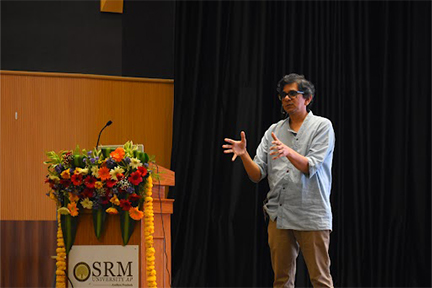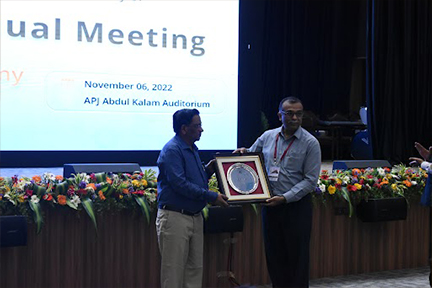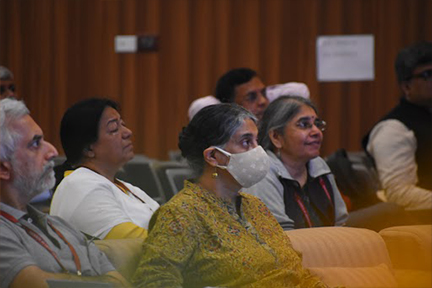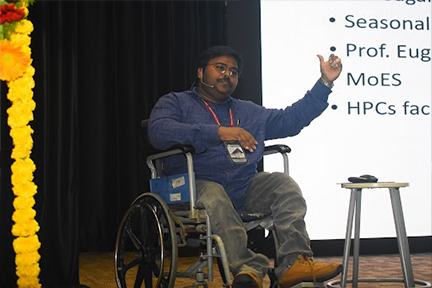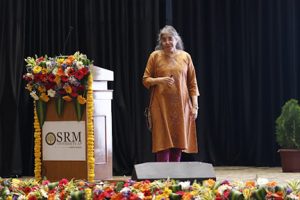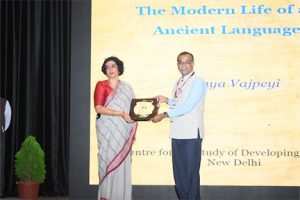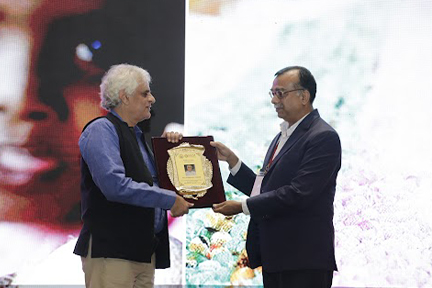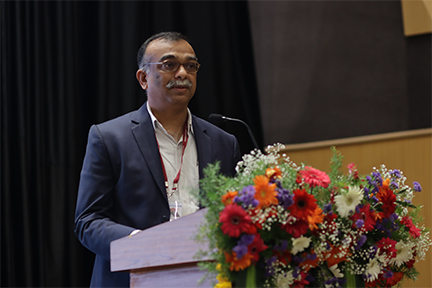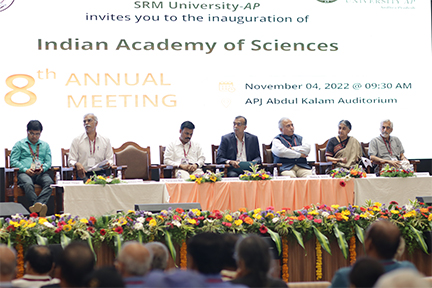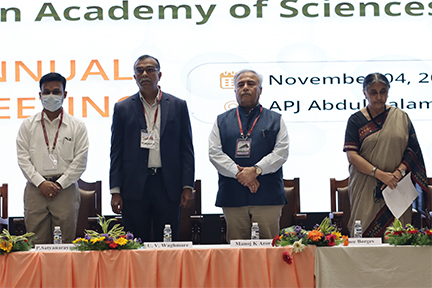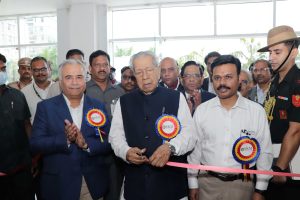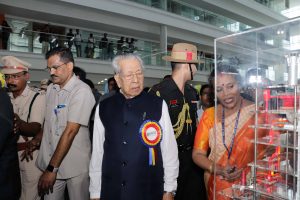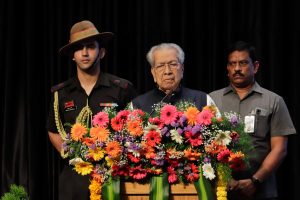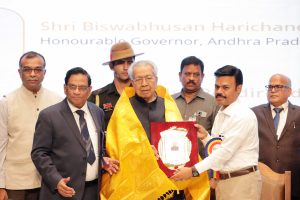SRM-AP All News
ALL News
- Acing national-level innovation marathon November 23, 2022
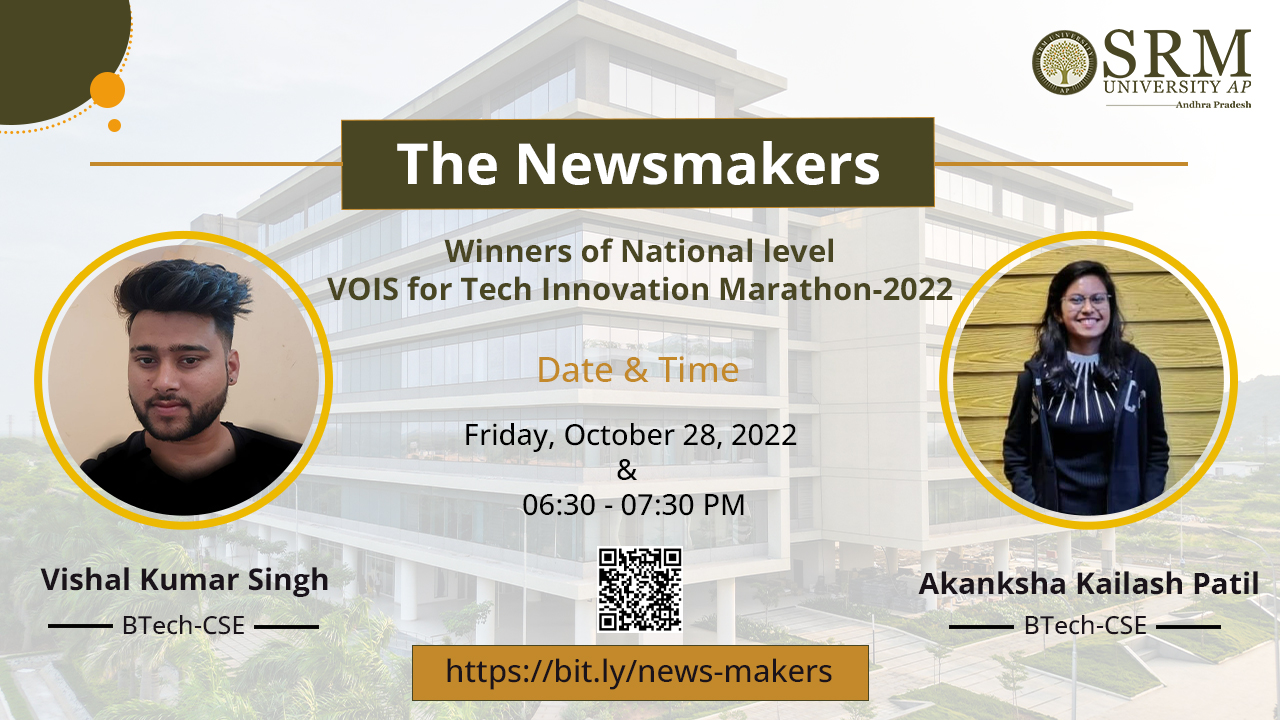 Vishal and Akanksha, students of SRM University- AP, won the National level VOIS for Tech Innovation Marathon 2022, which began on October 14 in Pune. They received a cash prize of Rs.2 lakhs, along with certificates and mementoes. Vodafone India, Voice, and Connecting Dreams Foundation jointly organised the Technology Marathon-2022 competition to bring out the latent technological creativity among engineering students.
Vishal and Akanksha, students of SRM University- AP, won the National level VOIS for Tech Innovation Marathon 2022, which began on October 14 in Pune. They received a cash prize of Rs.2 lakhs, along with certificates and mementoes. Vodafone India, Voice, and Connecting Dreams Foundation jointly organised the Technology Marathon-2022 competition to bring out the latent technological creativity among engineering students.Five hundred sixty teams from all over the country participated in the competition. Third-year Computer Science Engineering students Vishal Kumar Singh and Akanksha Patil participated in the competition on behalf of SRM University- AP. Both showed excellent talent and bagged the first position in the three-stage project presentation, Q&A, and review competitions. The organisers rewarded them with Rs.2 lakh and other souvenirs.
The winners, Vishal and Akanksha, were felicitated by President Dr P Satyanarayanan, Vice Chancellor Prof Manoj K Arora, and Registrar Dr Prem Kumar of SRM University- AP on Tuesday.
Continue reading → - One World, Many Cultures, One Home November 23, 2022
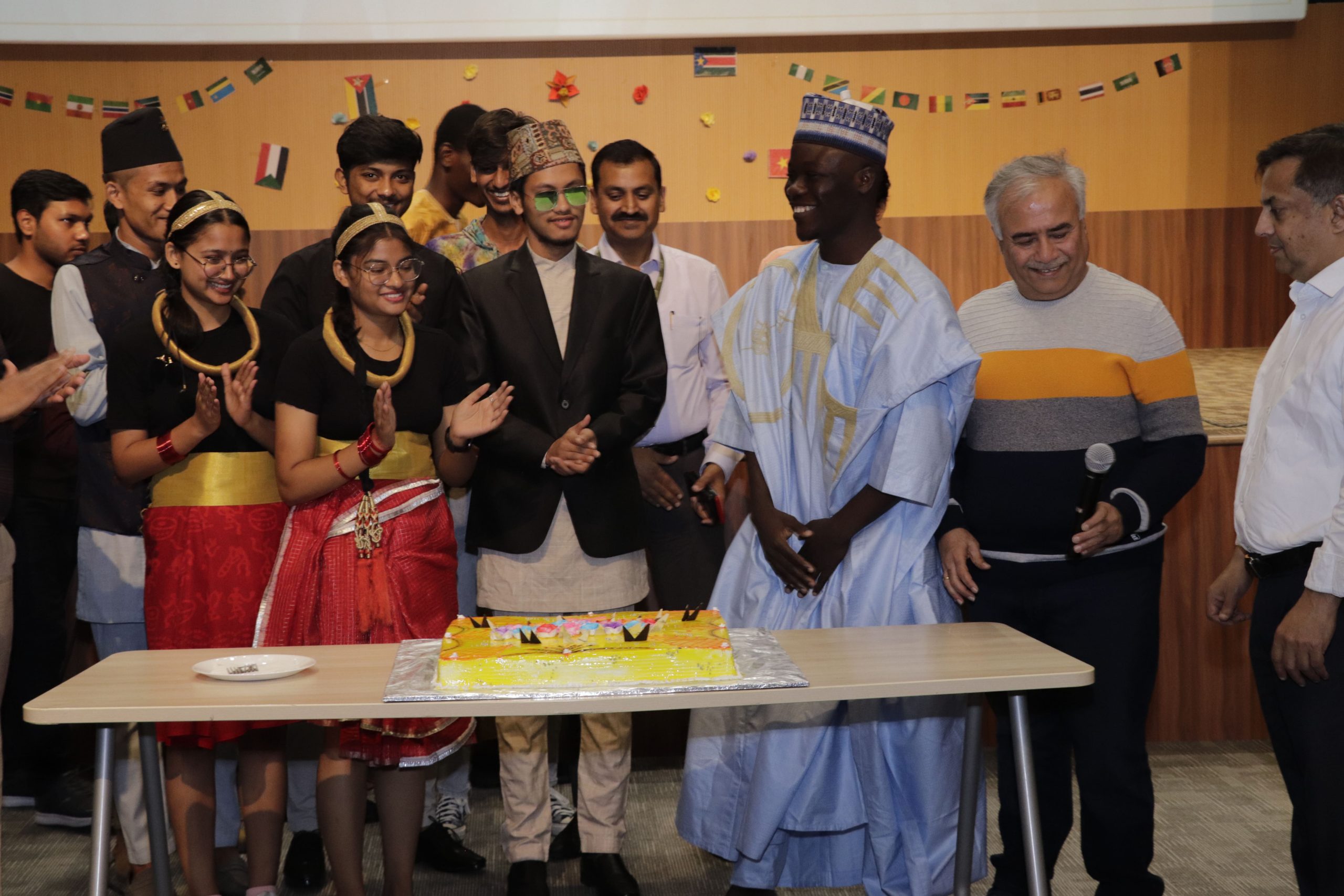 International Students’ Day is a global celebration of the student community that takes place on November 17 every year. Universities observe this day as a non-political celebration of the multiculturalism of their international students. The Directorate of International Relations and Higher Studies at SRM University- AP celebrated multiculturalism, diversity, and traditions with students from more than 30 countries across the globe on International Students’ Day.
International Students’ Day is a global celebration of the student community that takes place on November 17 every year. Universities observe this day as a non-political celebration of the multiculturalism of their international students. The Directorate of International Relations and Higher Studies at SRM University- AP celebrated multiculturalism, diversity, and traditions with students from more than 30 countries across the globe on International Students’ Day.“You are not international students; you are students of SRM AP. Once you are students of SRM AP, there is no differentiation between Domestic and International students”, said Vice Chancellor Prof Manoj K Arora addressing the students. On the occasion, Prof. Arora launched the Annual Magazine and International Students Handbook prepared by the Directorate of International Relations and Higher Studies. Dr P Naga Swetha, Associate Director, International Relations and Higher Studies, highlighted the importance of celebrating diversity and promoting creativity through cultural events. “At SRM AP, diversity is an essential binding agent of the interdisciplinary approach to education, as well as to the greater life experience”, she added.
Students enthusiastically talked about the facilities, curriculum, and support they receive at SRM AP. “I have no words to express how well I am treated on campus”, said Sara, a Syrian student in MBA Programme. “This is a very welcoming place, and I have made the right decision by choosing SRM AP to study in India”, added Muskan from Nepal. Tanira from Srilanka expressed his happiness in witnessing a variety of cultural programmes that foster respect and open-mindedness for other cultures.
To mark this occasion, international students showcased their rich culture through music, folk dance performances, and by identifying themselves in the traditional attires of their native countries. The students also presented a Nukkad Natak emphasising the significance of ‘one world, many cultures, one home’.
Aiming for significant global impact, the Directorate of International Relations and Higher Studies at SRM University-AP encourages the spirit of curiosity in students and faculty for multidisciplinary collaborations, inbound and outbound exchanges, research, and outreach programmes. A centralised portal to access/share international opportunities, higher studies training and support for students was launched by Mr Surendra Tipparaju, Director-Data and Artificial Intelligence at Microsoft recently.
Continue reading → - Classification of brain tumours using fine tuned ensemble of ViTs November 11, 2022
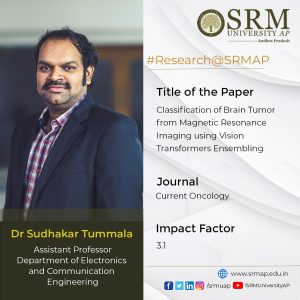
Primary brain tumours make up less than 2% of cancers and statistically occur in around 250,000 people a year globally. Medical resonance imaging (MRI) plays a pivotal role in the diagnosis of brain tumours and advanced imaging techniques can precisely detect brain tumours. On this note, Dr Sudhakar Tummala, Assistant Professor, Department of Electronics and Computer Engineering, has published a paper titled, “Classification of Brain Tumour from Magnetic Resonance Imaging using Vision Transformers Ensembling” in the journal Current Oncology having an impact factor of 3.1. The paper highlights the pioneering breakthrough made in the development of vision transformers (ViT) in enhancing MRI for efficient classification of brain tumours, thus reducing the burden on radiologists.
Abstract of the paper
The automated classification of brain tumours plays an important role in supporting radiologists in decision making. Recently, vision transformer (ViT)-based deep neural network architectures have gained attention in the computer vision research domain owing to the tremendous success of transformer models in natural language processing. Hence, in this study, the ability of an ensemble of standard ViT models for the diagnosis of brain tumours from T1-weighted (T1w) magnetic resonance imaging (MRI) is investigated. Pretrained and fine tuned ViT models (B/16, B/32, L/16, and L/32) on ImageNet were adopted for the classification task. A brain tumour dataset from figshare, consisting of 3064 T1w contrast-enhanced (CE) MRI slices with meningiomas, gliomas, and pituitary tumours, was used for the cross-validation and testing of the ensemble ViT model’s ability to perform a three-class classification task. The best individual model was L/32, with an overall test accuracy of 98.2% at 384 × 384 resolution. The ensemble of all four ViT models demonstrated an overall testing accuracy of 98.7% at the same resolution, outperforming individual model’s ability at both resolutions and their ensemble at 224 × 224 resolution. In conclusion, an ensemble of ViT models could be deployed for the computer-aided diagnosis of brain tumours based on T1w CE MRI, leading to radiologist relief.
A brief summary of the research in layperson’s terms
Brain tumours (BTs) are characterised by the abnormal growth of neural and glial cells. BTs causes several medical conditions, including the loss of sensation, hearing and vision problems, headaches, nausea, and seizures. There exist several types of brain tumours, and the most prevalent cases include meningiomas (originate from the membrane surrounding the brain), which are non-cancerous; gliomas (start from glial cells and the spinal cord); and glioblastomas (grow from the brain), which are cancerous. Sometimes, cancer can spread from other parts of the body, which is called brain metastasis. A pituitary tumour is another type of brain tumour that develops in the pituitary gland in the brain, and this gland primarily regulates other glands in the body. Magnetic resonance imaging (MRI) is a versatile imaging method that enables one to noninvasively visualise inside the body, and is in extensive use in the field of neuroimaging.
There exist several structural MRI protocols to visualise inside the brain, but the prime modalities include T1-weighted (T1w), T2-weighted, and T1w contrast-enhanced (CE) MRI. BTs appear with altered pixel intensity contrasts in structural MRI images compared with neighbouring normal tissues, enabling clinical radiologists to diagnose them. Several previous studies have attempted to automatically classify brain tumours using MRI images, starting with traditional machine learning classifiers, such as support vector machines (SVMs), k-nearest-neighbour (kNN), and Random Forest, from hand-crafted features of MRI slices. With the rise of convolutional neural network (CNN) deep learning model architectures since 2012, in addition to emerging advanced computational resources, such as GPUs and TPUs, during the past decade, several methods have been proposed for the classification of brain tumours based on the finetuning of the existing state-of-the-art CNN models, such as AlexNet, VGG16, ResNets, Inception, DenseNets, and Xception, which had already been found to be successful for various computer vision tasks.
Despite the tremendous success of CNNs, they generally have inductive biases, i.e., the translation equivariance of the local receptive field. Due to these inductive biases, CNN models have issues when learning long-range information; moreover, data augmentation is generally required for CNNs to improve their performance due to their dependency on local pixel variations during learning.Therefore, in this work, the ability of pretrained and fine tuned ViT models, both individually and in an ensemble manner, is evaluated for the classification of meningiomas, gliomas, and pituitary tumours from T1w CE MRI at both 224 × 224 and 384 × 384 image resolutions.
Dr Sudhakar Tummala has mentioned the social implications of the research by expounding that the computer-aided diagnosis of brain tumours from T1w CE MRI using an ensemble of fine tuned ViT models can be an alternative to manual diagnoses, thereby reducing the burden on clinical radiologists. He also explains the future prospects of his research, which is to add explainability to the ensemble model predictions and to develop methods for precise contouring of tumour boundaries.
Details of Collaborations
Prof Seifedine Kadry, Department of Applied Data Science, Noroff University College, Kristiansand, Norway.
Dr Syed Ahmad Chan Bukhari, Division of Computer Science, Mathematics and Science, Collins College of Professional Studies, St. John’s University, New York, USA.
Continue reading → - Doctoral scholar secures visiting fellowship November 9, 2022

Exposure to international research opportunities promotes empirical learning at an impeccable level. International research ventures aid scholars to explore novel research avenues enabling a transformative progress for society through the field of science. The Department of Chemistry is glad to announce that Ms Jayasree K, PhD scholar, has been accepted for Short-Term Research Internship (STRI) for a period of six months from the Research Center of Environmental Medicine, Kaohsiung Medical University, Taiwan.
Ms Jayasree has been elevated in receiving the offer and delightfully keen on the new avenues she could explore through this opportunity. She is currently working in the field of surface-enhanced Raman spectroscopy (SERS). In this particular research area, her major research objective is the design and development of a novel SERS substrate for food and bioanalysis.
“My internship mentor, Prof. Vinoth Kumar, KMU University is an expert in mass spectroscopy and High-performance liquid chromatography (HPLC). Therefore, I have an option to hyphenate the Raman technique along with mass spectroscopy which leads Raman research to the next level for various applications”, commented Ms Jayasree on this incredible opportunity.
Her internship at Kaohsiung Medical University (KMU) is based on the motive of research on food and environmental toxicity which would provide guidance on her first research project in the field of food analysis.
She has offered her sincere gratitude to her supervisor, Dr Rajapandiyan JP, Department of Chemistry for his constant support and advice from the application process to proposal writing, experimental planning etc. She also thanked SRM University- AP in providing support through the process and extending travel allowance and guidance.
Ms Jayasree utilizes this great opportunity to explore and discover herself, developing both personally and professionally. Through this internship she hopes to learn new skills, expand her knowledge in the field of research and explore career options in Taiwan.
Continue reading → - The prevalence of digital divide and agrarian crisis in rural India November 7, 2022
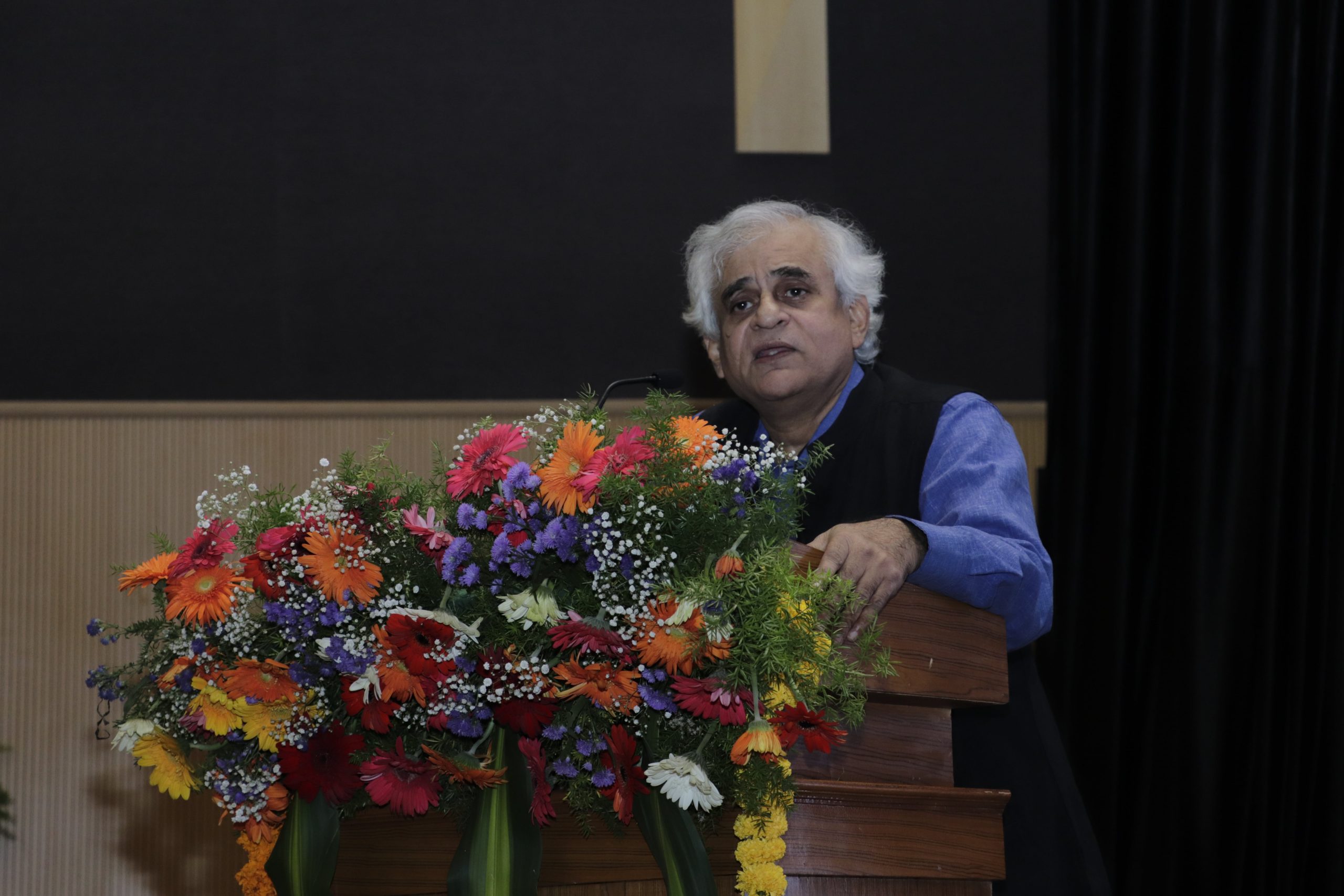 Eminent Columnist P Sainath addressed the gathering of scientists and researchers from various parts of the country in the Public Lecture Telling the stories of rural Indians in the digital age: The People’s Archive of Rural India. The lecture was organised as a part of the 88th Annual Meeting of the Indian Academy of Sciences at SRM University-AP, Andhra Pradesh.
Eminent Columnist P Sainath addressed the gathering of scientists and researchers from various parts of the country in the Public Lecture Telling the stories of rural Indians in the digital age: The People’s Archive of Rural India. The lecture was organised as a part of the 88th Annual Meeting of the Indian Academy of Sciences at SRM University-AP, Andhra Pradesh.P Sainath talked about the People’s Archive of Rural India (PARI), which brings together science, technology, culture and literature. PARI is a free digital space wholly dedicated to rural India, publishing in 14 languages in India with a huge volunteer force of translators. Though rural India accounts for 69% of the total population of India, their representation in the frontier of national dailies are limited to a meagre total of 0.67 percent. P Sainath commented on this ostracization by calling out the tainted and prejudiced rationale of media houses on neglecting rural life as they offered no credible revenue for their media coverage.
Mr Sainath also talked about the content of his upcoming book The Last Heroes: Foot Soldiers of Indian Freedom expressing that, “It is a gigantic tragedy that this generation and the coming generation won’t be seeing our freedom fighters”. He further talked about the alarming status of India in the environmental performance index and global hunger index and the need to address the agrarian crisis and the growing digital divide in society. “Equitable distribution of opportunities paramount to the democratisation of digital content “, affirmed P Sainath as a concern about online education. IASc President Prof. Umesh Waghmare thanked Mr P Sainath for sensitising the scientific community about the pertinent issues around them.
Continue reading → - SRM University- AP hosted the Science and Technology Exhibition of ISRO&DAE November 7, 2022
SRM University-AP hosted the Science and Technology Exhibition organised by ISRO & DAE from November 03-06, 2022, as a part of the 88th Annual Meeting of the Indian Academy of Sciences, Bengaluru. The exhibition laid the foundation for scientific discourse in recent developments in nuclear tech, space tech and rocket science. Modern research models and detailed exhibition panels arranged at the tech venue, engaged students with the latest research technologies.
The scientific convention witnessed a prolific participation from school students from the regional locale with almost 20,000 students from various schools like Delhi Public School, S.T.B.E.M. High School etc. attending the event. Students had the opportunity to associate with renowned scholars and researchers and experience the technological advancements in ISRO & DAE space and nuclear tech. They were free to explore the exhibitions under the guidance of student volunteers of SRM AP.
The ISRO exhibition, inaugurated by the Honourable Governor of Andhra Pradesh, Shri Biswabhusan Harichandan, showcased prototypes of satellites/vehicles with a detailed description on their conception, manufacturing and working principles. Exhaustive exhibition panels displayed information on breakthrough space ventures including the Gaganyaan Mission, Mars Orbiter Mission and many others. Chanda, a 9th grader from DPS, commented that she was ecstatic to visit the exhibition and the campus. The young space enthusiast utilised this opportunity to learn about the different models and their application and vocalised her desire to become the next Kalpana Chawala.
Demonstration models illustrating novel nuclear tech and atomic models were the highlights of the DAE exhibition. Followed by the inauguration, the exhibited prototypes were briefly explained by Jalaja Madan Mohan, Head Technical Co-ordinator & Public Awareness Section, IGCAR, DAE to the Honourable Governor and other dignitaries visiting the exhibition. The DAE exhibition provided an incredible opportunity for young students and researchers to explore the evolving domain of atomic and nuclear science.
The enthusiastic and active participation of students were graciously welcomed by Pro Chancellor of SRM AP, Dr P Sathyanarayanan, Vice Chancellor, Prof Manoj K Arora, and Pro Vice Chancellor, Prof D Narayana Rao. The students were dispensed with knowledge about modern technologies and research fields to promote research interest for the progress of society. They were also made aware of the growing career opportunities in the reputed organisations of ISRO & DAE. Lunch followed by a tour of the campus acquainting them with the state-of-the-art facilities were also provided.
Continue reading → - The finale of the 88th Annual Meeting of Indian Academy of Sciences at SRM University- AP November 7, 2022
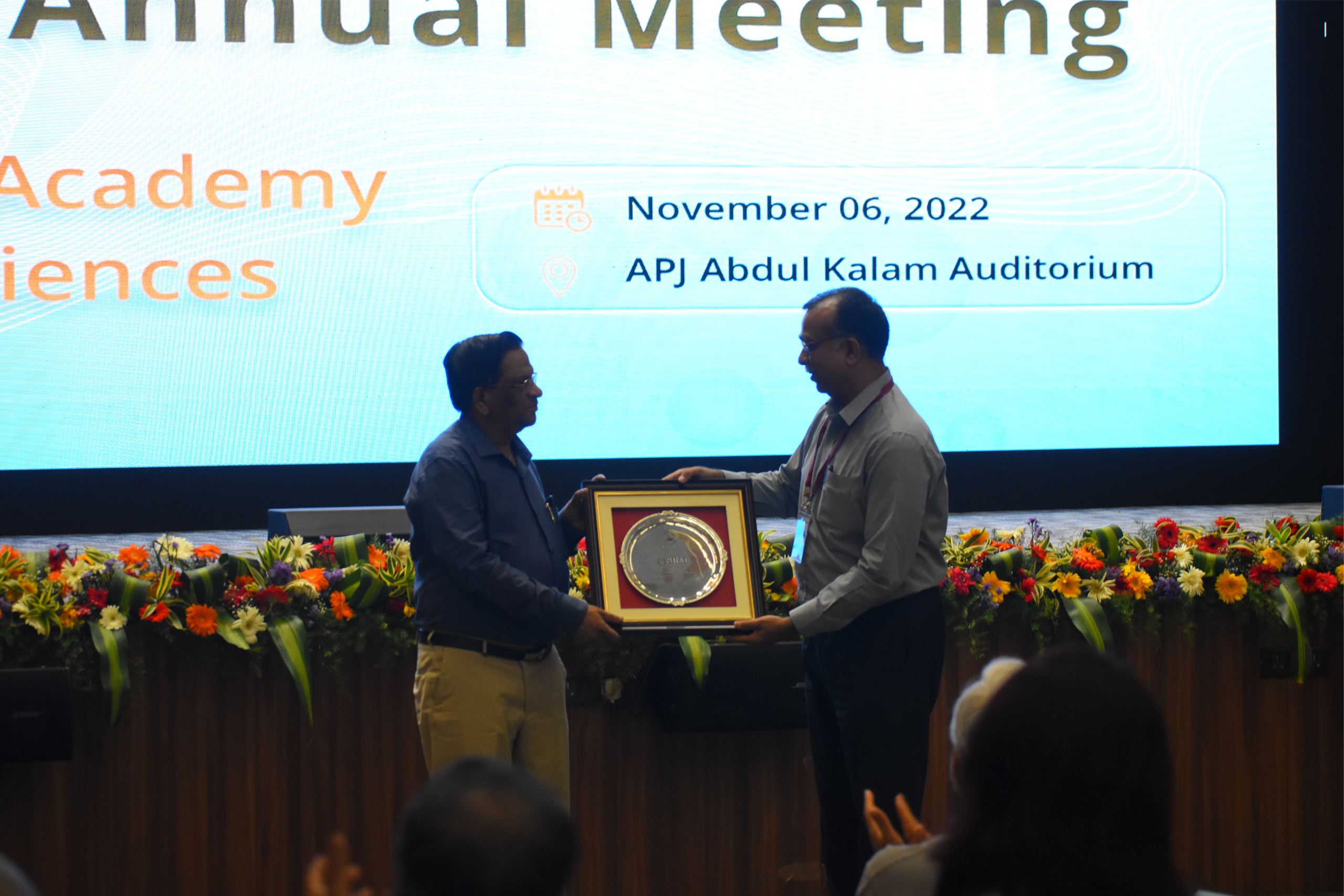
The three-day-long 88th Annual Meeting of the Indian Academy of Sciences came to an end at SRM University- AP on November 06, 2022. On the final day of the Meeting, Dr Swapan K Ghosh, University of Mumbai, chaired the first set of Lectures by Fellows/Associates Dr Prabhat Mandal, SN Bose National Centre for Basic Sciences, Kolkata; Dr Jitendra K Bera, IIT, Kanpur and Dr P Sreenivas, University of Hyderabad, were the speakers.
Dr Pranab Mandal spoke on the topic “A new paradigm for understanding solids”. He briefly discussed the conventional electronic states, which have been realised in the band theory of solids. The theoretical foundation and experimental realisation of topological electronic states in several condensed matter systems were also covered in the lecture.
“Water as a reactant in organometallic catalysis” was the topic presented by Dr Jitendra K Bera. The talk focused on the hydration of nitriles and alkynes, olefin oxygenation, alcohol oxidation to acid, and oxidative deamination of primary amines using water.
The last speaker of the session was Dr P Sreenivas, and he dealt with the topic “An advanced Ensemble Kalman Filter based ocean-atmospheric coupled data assimilation system and its impact in enhancing the Indian monsoon predictions”. He elaborated on how the new system incorporates theoretically advanced features of flow-dependency and ensemble-based analysis, and the predictions using the new system simulate the large-scale monsoon features and convection canters well and improves Indian Summer-monsoon-rainfall prediction skill with a gain of one month lead time.
Dr A Jayaraman, Bangalore University, Bengaluru, was the Chairperson to the lectures by Dr Suchana Taral, Pondicherry University, Puducherry; Dr Gobardhan Das, JNU, New Delhi and Dr Sneha Sagarkar, SP Pune University.
Dr Suchana Taral’s talk was on “Source-to-sink pathway of the Himalayan sediments: New evidence from the eastern Himalayan foreland”. In the lecture, she proposed a new model for the evolution of the eastern foreland basin, taking into account the hierarchical stratigraphic response to eustatic and tectonic forcing.
“Mycobacterium Tuberculosis programs mesenchymal stem cells to establish dormancy and persistence” was the topic presented by Dr Gobardhan Das. He explained that Tuberculosis treatment displays a biphasic bacterial clearance, in which the majority of bacteria clear within the first month of treatment, but residual bacteria remain nonresponsive to treatment and eventually may become resistant. Then he proceeded to show that Mycobacterium Tuberculosis was taken up by mesenchymal stem cells (MSCs), where it established dormancy and became highly nonresponsive to isoniazid, a major constituent of directly observed treatment short course (DOTS).
Dr Sneha Sagarkar talked about “Reward memory recall: Role of Glutamatergic Neurotransmission in the dentate gyrus”. She explained why the reward association process is critical for memory-guided decision-making that deteriorates mental illnesses such as binge eating disorders (BED), drug addiction, and schizophrenia.
The Special Lecture titled “Nobel Prize for Physics 2022: From Foundational Questions in Quantum Physics to Cutting Edge of Today” by Sadiqali Rangwala, RRI, Bengaluru, had V A Raghunathan, RRI, Bengaluru as the chairperson. He discussed the physics problems from first principles and highlighted how the pathbreaking experiments were done, which led to the Nobel Prize.
In the Public Lecture titled “The Modern Life of an Ancient Language”, Dr Ananya Vajpeyi from the Centre for the Study of Developing Societies, New Delhi, revisited the history of Sanskrit in modern times. According to the speaker, Sanskrit finds new life and meaning in a world shaped by nationalism, science, and struggles over identity. Vibrant cultural programmes by the students of SRM AP were also organised as a part of the 4-day long celebration of Science and Technology on campus. IASc President Prof Umesh Waghmare felicitated SRM AP Pro Vice-Chancellor Prof D Narayana Rao for successfully hosting the 88th Annual Meeting of the Academy.
Continue reading → - The second day of 88th Annual Meeting of Indian Academy of Sciences at SRM University- AP November 7, 2022
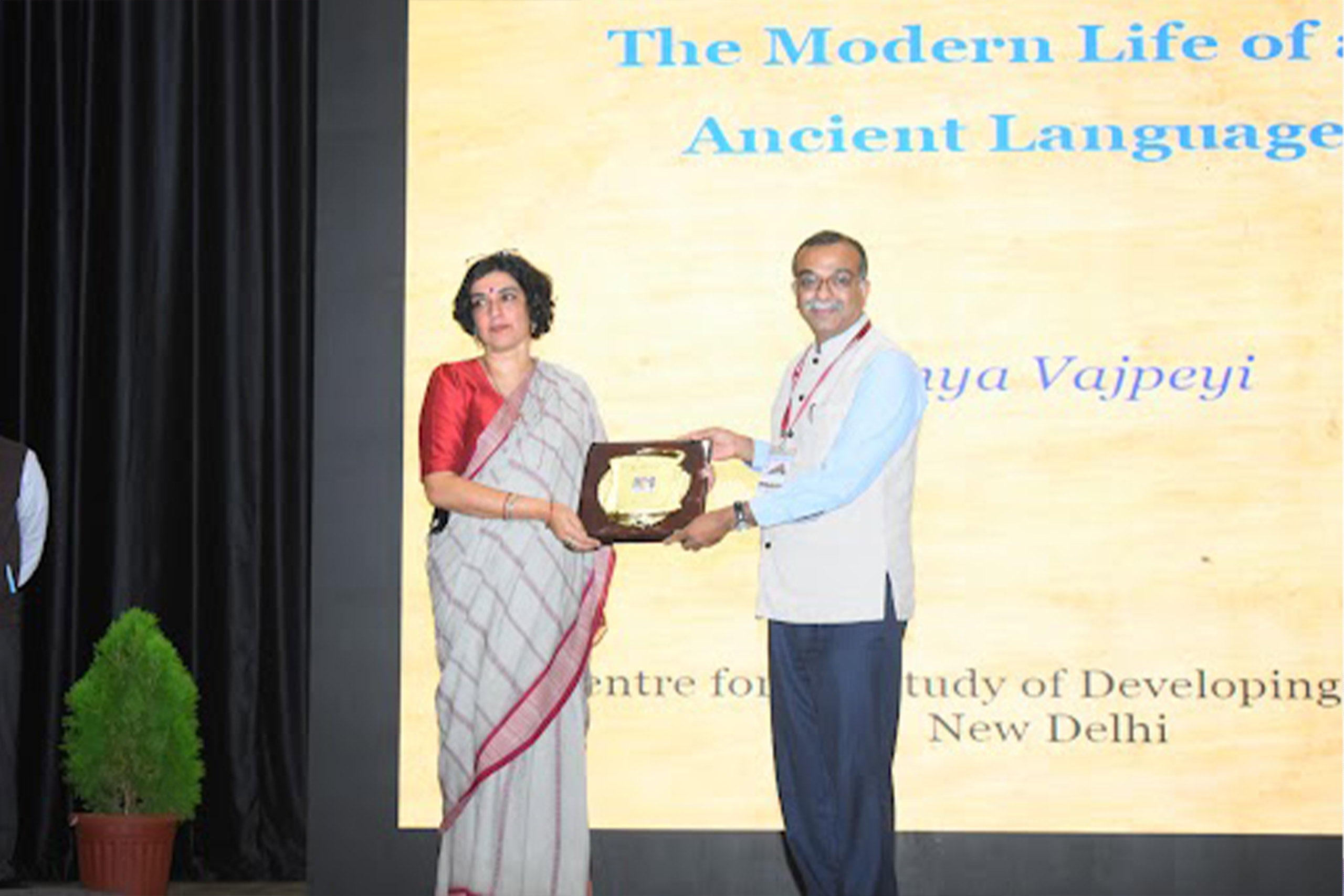
The second day of the 88th Annual Meeting of the Indian Academy of Sciences held at SRM University- AP on Saturday, November 05, 2022, continued to behold the momentum of the first day of the gathering. The highlights of the day were the Lectures by fellows and associates, a Symposium on “Floods in the Anthropocene,” and a public lecture on “The Modern Life of an Ancient Language” by Ananya Vajpeyi, Centre for The Study of Developing Societies, New Delhi.
The first session in the morning, lectures by fellows and associates, was chaired by G V Anand, Dayanand Sagar University, Bengaluru. The series of lectures commenced with a talk on “The Novel (IZ4) spreading code design for NavIC’s LISPS signal” by P Vijay Kumar, IISc, Bengaluru. The lecture focused on the NAVigation with Indian Constellation (NavIC), an indigenous regional navigation satellite system developed by ISRO, and other related topics.
Anil K Tripathi, BHU, Varanasi, did the second lecture on the “Regulatory cascades of alternative sigma factors are involved in controlling rhizocompetence in a plant growth promoting rhizobacterium, Azospirillum brasilense.” The lecture focused on Azospirillum brasilense, one of the most ubiquitous plant growth-promoting rhizobacteria, which can sense and detoxify Reactive Oxygen Species (ROS) released by plants. Furthermore, the talk proceeded to discuss how bacteria respond to changes in their internal and external environment by expressing genes needed to cope with the challenges of the altered environment. The session elaborated on the changes faced in the root zone, the rizhocompitance of plants, the fundamental ways in which the roots respond to changes happening in the roots, the effect of stigma factors, and many more.
Atul Geol, CORI, Lucknow, did his lecture on “Development of donor-acceptor-based fluorescent dyes for diagnostics and biomedical applications.” He detailed the pioneered breakthrough innovations of basic building blocks for synthesising TAQMAN-like probes and alternate conjugation chemistry to develop complete RT-PCR kits for detecting SARS-CoV-2 variants. He also expressed how his team is engaged in developing efficient approaches for synthesising new organic fluorescent dyes with absorption and emission at various wavelengths for biomedical and diagnostics applications.
The Development origins of Health and diseases (DOHaD)) hypothesis suggests that early life exposure, including maternal nutrition and phenotype, can predict the risk of non-communicable diseases (NCDs). The session on “Early life exposure and future risk of non-communicable diseases: Relevance in the Indian context” by GR Chandak, CCMB, Hyderabad, elaborated this hypothesis furthermore. It explained the dissection of gene-gene and gene-environment interaction that can predict the future risk of NCDs.
The lectures by fellows and associates were succeeded by a symposium on “Floods in the Anthropocene.” Introduction to this exciting session was done by the Convener Pradeep P Mujumdar, IISc Bengaluru. He provided an overall idea regarding the title of the symposium. He reflected on the ecological and geographical aspects of the topic. He talked a bit about the repeating patterns of floods, the changing frequency of rains, the effect of reservoir operation on floods, etc.
Rajiv Sinha from IIT, Kanpur, was the first to deliver a lecture in this session and was on the “Hydrogeomorphology and sediment dynamics of floods.” He explained that there are particular settings where floods occur more frequently than in other riverbeds and stated that understanding this can help predict the potential sites of floods. The session discussed relevant topics such as the worldwide distribution of floods, Floods in large rivers, Natural or human-induced reasons for floods, Rivers in the Anthropocene concerning specific reference to flood hazards, geomorphology of rivers, floods, and sediment dynamics, dynamic flood topography and many more. The session also put a thought upon the false sense of security while living close to larger rivers that eventually result in irreversible loss. Moreover, he introduced the idea of integrating river morphology into flood management.
The topic “Extreme precipitation under human-induced climate change” was handled by Subimal Ghosh, IIT, Mumbai. Spatial and temporal resolutions of rainfall, extreme precipitation, thermodynamic and dynamic contributions to changing precipitation, atmospheric instability and precipitation, future changes in different warming levels, impacts of urbanisation, and many other topics were under discussion.
The next session on “Deciphering the role of climate change in floods” by Arpita Mondal, IIT Mumbai, explained how a once-in-a-thousand-year event, flood, became a once-in-10-years event with a detailed analysis of the recent flood emergencies occurred in India. She also stressed the attribution analysis of floods, anthropologic climate change, Spatio-temporal scales to define the event, and many other areas.
The last speaker of the symposium was J Indu, IIT Mumbai, and was centered around the topic “Floods from the vantage point of Radars.” She started the lecture by questioning the inaccuracy of observing precipitation from satellites for examinations. She also inspected the network of weather radars, forecasting using radar-based rainfalls, the time limit of radar data assimilation, etc. The symposium came to an end with an exciting interactive session that raised numerous constructive queries and composed a space for incredible engagement.
The afternoon sessions started with lectures by fellows and associates, and C Pulla Rao from IIT Tirupati served as the chairperson of the series of lectures. “Distinguished varieties in the polydisc and dilation of commuting matrices” by Sourav Pal, IIT Mumbai, set the start of the lectures.
Binod Sreenivasan, IISc Bengaluru, was in charge of the next session on “Understanding Earth’s magnetic reversals.” He conferred about one of the long-standing questions in dynamo theory: whether the preference for the axial dipole is due to a purely hydrodynamic process influenced by planetary rotation or due to a magnetohydrodynamic process influenced by both rotation and the self-generated magnetic field.
The talk “You are what you eat: linking metabolism to physiology & health” by Ullas K Seetharam, TIFR Mumbai, put forward the importance of discovering or understanding diet or metabolism-driven mechanisms that govern psychological homeostasis to tackle the explosive burden of non-communicable diseases.
The session ended with Meena B Mahajan, IMSc Chennai, through her lecture on “What is hard to prove, and why?”. She instructed formal proofs, the design of formal proof systems and demonstrated its limitations.
Continue reading → - 88th Annual Meeting of Indian Academy of Sciences begins at SRM University-AP November 7, 2022
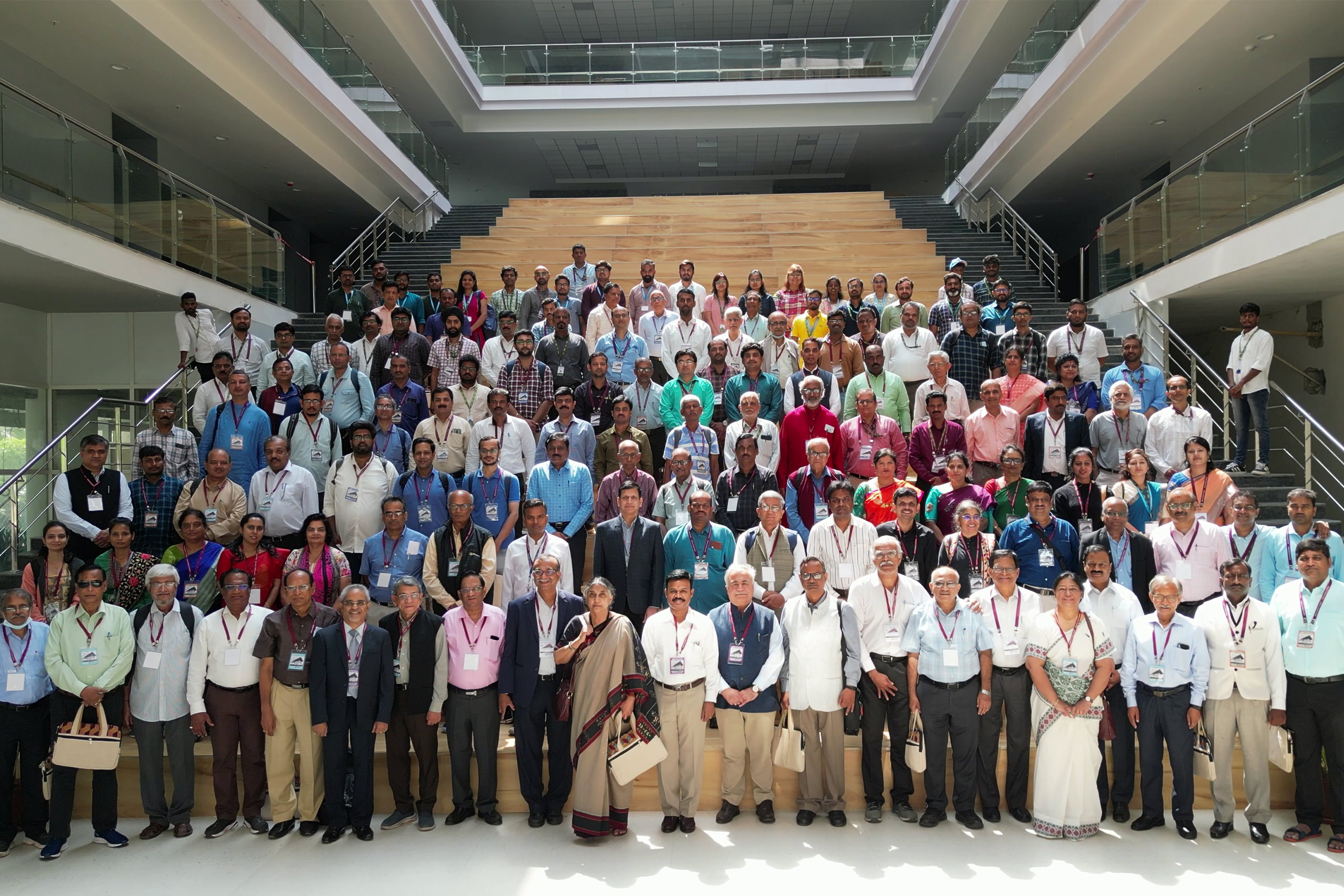
The 88th Annual Meeting of the Indian Academy of Sciences began on Friday, November 04, 2022, at SRM University- AP. The event, which spans three days, features distinguished fellows and associates of IASc and renowned Professors from premier institutions across the country. Prof. Umesh V Waghmare, President of the Indian Academy of Sciences, inaugurated the Annual Meeting with his presidential address on “Instabilities of crystals and their functional properties”.
Prof. Waghmare’s lecture revolved around the usage of fundamental laws of Physics in identifying instabilities in crystals. It also acquainted the audience with how these fundamental concepts hold supreme importance in the development of predictive models that capture interactions between the instabilities and external forces to predict the material-specific functional behaviour of advanced materials. The noteworthy remarks were Illustrated with crystal instabilities of polar phonons, spin-ordering, and strain that drive the functional properties of ferroelectrics, antiferromagnets, and shape memory alloys, respectively.
In his welcome speech, Prof Manoj K Arora, Vice-chancellor of SRM University- AP, requested the fellow and associate members of IASc to encourage and instil their unwavering admiration and inclination for research and development into the faculty of educational institutions. He also expressed his concerns about how science and technology are instructed to students in classrooms; considering the enthusiasm and genuine yearning for innovations; it should evoke among students to retain the potential for constructive explorations in ages to come.
“The things that kept an organisation like ISRO going beyond human imaginations and expectations is the solemn belief in themselves, the teamwork and the right sublime combination of the wisdom of past generations and the innovative outlook of the young generation”, stated Prof D Narayana Rao as he expressed his immense acclamation towards the institutes that constitute to the research and development of the country. He also asserted why discovering basic science matters or should be appreciated as they might get transformed into the theories of tomorrow. He also added that the scientific community is destined to live up to the responsibility and highlighted the need to upgrade intellectual and material prosperity. He also emphasised that educational institutions are the backbone of research and development in a country, and there are eccentric career opportunities for the youth in the coming years.
Pro-Chancellor of SRM University- AP, Dr P Sathyanarayanan, thanked IASc for believing in the university’s calibre to be a host and a part of the initiative. He said that he is expecting around 10000 students to benefit from the event. Furthermore, he elaborated on the potential of industry and academia coming together for the improvement of research and development of the country.
The inauguration was followed by a special lecture on “Uniqueness of plant mitochondria: Relevance to crop improvement and climate change” by A S Raghavendra, University of Hyderabad. Swagata Gupta from IIT Kharagpur chaired the lecture. The session concentrated on the distinct features of plant mitochondria that set them apart from animal mitochondria. The speaker elaborated on how mitochondrial metabolism can help plants to adapt to climate changes in terms of flooding, global warming, and elevated CO2.
Afternoon sessions started with lectures by fellows and associates and were chaired by K Bhanu Sankara Rao, University of Hyderabad. The first lecture by Dr D B Ramachary, University of Hyderabad, on the “Discovery of sustainable organocatalytic reactions: Expansion of substrate/catalysts scope”. Discussed the discovery of in-situ generated novel reactive primary catalytic species. The session also focused on their direct applications in a variety of selective green bond formations to furnish the chiral functionalised molecules, drugs, drug-like molecules, natural products, and pharmaceuticals. The second speaker Aditya Bandyopadhyay from IIT Kharagpur talked about “Electrified fluid interfaces- Waves and pattern formation”. He detailed how Interactions of electric fields at the interface of two fluids can lead to particle agglomeration at interfaces, as applied to DNA motion at the interface of two aqueous solutions.
The second speaker Aditya Bandyopadhyay from IIT Kharagpur talked about “Electrified fluid interfaces- Waves and pattern formation”. He detailed how Interactions of electric fields at the interface of two fluids can lead to particle agglomeration at interfaces, as applied to DNA motion at the interface of two aqueous solutions.
The special lecture was followed by a Symposium on Green energy. Dr Ranjit Thapa, Associate Dean- Sciences, SRM University- AP, introduced the symposium that provided a deep understanding of hydrogen generation, hydrogen fuel cells, and beyond hydrogen. Dr Ashok K Ganguli, IIT, New Delhi, handled the first session of the symposium on “Photoelectrochemical water splitting for green energy”. The key process of converting water into clean and renewable hydrogen fuel by using highly efficient photocatalysis was discussed. Furthermore, the session also underlined the growing interest in suitable semiconductor materials as photocatalysts for efficient photoelectrochemical water-splitting applications. The transformation needed to achieve the goals of the Paris agreement, the necessity of renewable energy, the difference between clean, green, and renewable energy, photocatalysis, and many more interesting areas were covered during the lecture. The next lecture on “Low-carbon biohydrogen: Enabling through biorefinery” was delivered by S Venkata Mohan, IICT Hyderabad, and was followed by another talk on “Electrochemical energy systems: Hydrogen generation and its use in fuel cells” by S Sampath, IISc, Bengaluru. The symposium came to a close with the lecture of Ramendra Sundar Dey, Institute of NanoScience &Technology, Mohali, on “Electrochemical nitrogen reduction reaction for the synthesis of ammonia: A pathway to a green future”.
All the sessions were followed by meaningful discussions and dialogues with distinguished participants. IASc Secretaries Prof Renees Borges, Prof. Vijay Mohanan Pillai, Treasurer Raghunathan V A and many other dignitaries from the Indian Academy of Sciences, Bengaluru and SRM University-AP, Andhra Pradesh, were present at the sessions.
Read more about the public lecture of P Sainath
Continue reading → - Governor Shri Biswabhusan Harichandan inaugurated ISRO & DAE Exhibition in SRM University-AP November 6, 2022
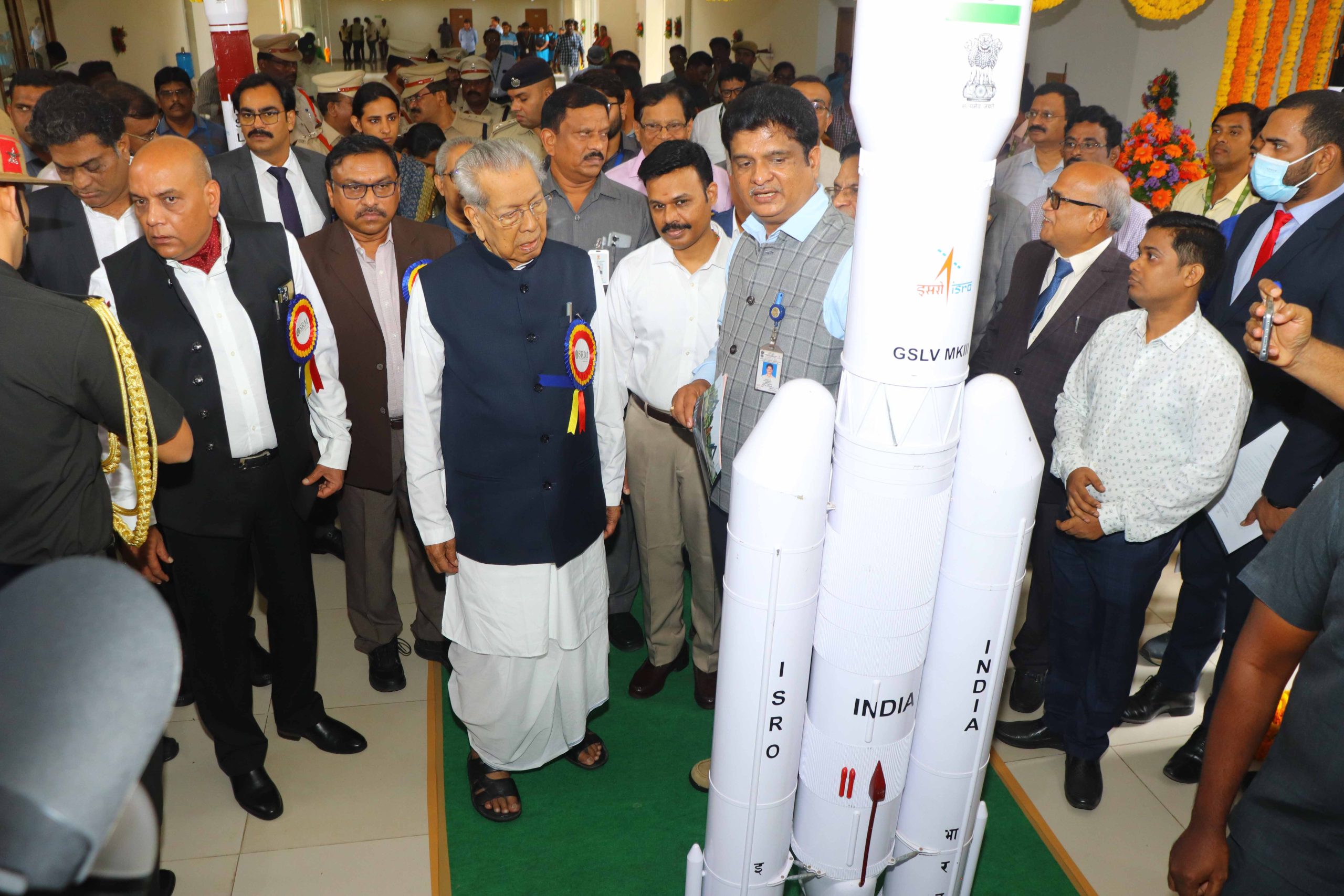 “The societal expectations from science and technology are increasing. Thus, the scientific community has the responsibility to rise to the expectations” said Hon’ble governor to the intellectual gathering.
“The societal expectations from science and technology are increasing. Thus, the scientific community has the responsibility to rise to the expectations” said Hon’ble governor to the intellectual gathering.Governor of Andhra Pradesh, Shri Biswabhusan Harichandan inaugurated the Science and Technology Exhibition, by ISRO and DAE, at SRM University-AP, Andhra Pradesh, on November 03, 2022. The exhibition, organised as a prelude to 88th Annual meeting of the Indian Academy of Sciences, will be open till November 06 on the campus.
“It is known that science and technology are the established currency of the geo-political world. Any country that has made advances in prosperity has invariably depended on science and technology”, remarked Sri Biswabhusan Harichandan addressing the science and technology enthusiasts from all over the country. He reiterated Prime Minister Shri Narendra Modi’s vision of the nation – “Jai Jawan, Jai Kisan, Jai Vigyan, Jai Anusandhan”. He further said that “a developed nation is one that has the capacity for wealth, literacy, high quality of life and national security . This is your country, be proud of it, go ahead and our great ambition of Athmanirbhar will be fulfilled through each one of us”, to the audience of school students came from different parts of the state to attend the exhibition.
Addressing the gathering, Prof Umesh Waghmare, President of the Indian Academy of Sciences (IASc), emphasized that the important mandate of IASc is to uphold the cause of progress and to connect with society through the domain of science and technology. “I am really excited to associate with the students through the exhibitions and meetings organised at SRM AP”, he added.
Prof Manoj K Arora, Vice Chancellor of SRM University- AP, delivered the welcome address and highlighted the achievements of the university in the past five years. Pro-Chancellor, Dr P Sathyanarayanan emphasised the impact of Campus Social Responsibility for the progress of the country. “It is our proud privilege to host the 88th Annual Meeting of IASc at our university campus”, he added. Pro Vice- Chancellor, Prof D Narayana Rao highlighted the achievements of Indians trained in the Athmanirbhar India. He lauded the proactive application of science and technology and the insatiable quest for research and development in the areas of national priority such as world-class communications and remote sensing satellites.
Dr. Pola Bhaskar IAS, Commissioner of Collegiate Education; SRM AP Registrar and many other dignitaries from Indian Academy of Sciences and State and Central government were present on the inaugural function.
Around 1000 students from different schools across the state participated in the first day of Science and Technology Exhibition. The exhibition aims to be an engaging and invigorating platform for students from various regions.There are demonstration models of rocket energy, space research, and nuclear technology, interactive videos on the evolution of technology in ISRO and DAE, and meetup with renowned scientists and technologists. Participants can converse with eminent scientists and researchers on their pathbreaking research works. Apart from the pioneering research models, the exhibition proffers a brief account of various career opportunities at ISRO and DAE. The exhibition will last for the next four days and will be open to the participants free of cost.
In Media: Press Coverage Continue reading →


